
Summary
On June 4–7, 1942, American naval and air forces met the Japanese near Midway Atoll in one of the most decisive naval battles of the war. The Battle of Midway would become a turning point in the naval war in the Pacific, as the Japanese losses sustained there proved irreparable.
Background
The Japanese had developed a complex plan that involved attacking and occupying both the Aleutian Islands in Alaska and Midway Atoll, not far from Hawaii, in an attempt to lure the American fleet into a trap. However, American cryptanalysts were able to break enough of the Japanese code to be fairly certain of the basics of the plan. So American admiral Chester Nimitz, commander of the Pacific Fleet, sent two task forces to meet the Japanese at Midway.
Battle of Midway
The Japanese began carrier-based air attacks on the Midway Islands at dawn on June 4 in preparation for a land invasion. But various waves of Midway- and carrier-based American planes found the Japanese fleet and caused devastating damage to all four of the Japanese carriers present. All four would eventually sink from the attacks.
However, the Americans also sustained a carrier loss when—on the afternoon of the 4th—Japanese planes found the USS Yorktown and damaged her badly enough that the captain had the ship abandoned. A Japanese submarine finished off the Yorktown two days later and sunk it.
Aftermath and Effects
As a result of the various engagements between the Japanese and Americans from June 4th to 7th, the Japanese sustained heavy losses: 3,000 men killed and 4 carriers sunk, while the Americans lost 300 men and 1 carrier. The Battle of Midway would prove a turning point in the naval fight in the Pacific, as it hobbled the Japanese carrier fleet and put Japan on the defensive at sea for the remainder of the war.
Learn more about the Battle of Midway through historical newspapers from our archives. Explore newspaper articles, headlines, images, and other primary sources below.
Articles and Clippings about the Battle of Midway
 Early news report about the Japanese air attacks on Midway on June 4, 1942 Thu, Jun 4, 1942 – Page 1 · The Post-Register (Idaho Falls, Bonneville, Idaho) · Newspapers.com
Early news report about the Japanese air attacks on Midway on June 4, 1942 Thu, Jun 4, 1942 – Page 1 · The Post-Register (Idaho Falls, Bonneville, Idaho) · Newspapers.com Hawaiian newspaper front page headlines about the beginning of the Battle of Midway Fri, Jun 5, 1942 – 1 · Honolulu Star-Bulletin (Honolulu, Honolulu, Hawaii, United States of America) · Newspapers.com
Hawaiian newspaper front page headlines about the beginning of the Battle of Midway Fri, Jun 5, 1942 – 1 · Honolulu Star-Bulletin (Honolulu, Honolulu, Hawaii, United States of America) · Newspapers.com "Japan's Fleet Crippled, Driven Back at Midway," June 6, 1942, headlines Sat, Jun 6, 1942 – Page 1 · The San Bernardino County Sun (San Bernardino, San Bernardino, California) · Newspapers.com
"Japan's Fleet Crippled, Driven Back at Midway," June 6, 1942, headlines Sat, Jun 6, 1942 – Page 1 · The San Bernardino County Sun (San Bernardino, San Bernardino, California) · Newspapers.com Newspaper headlines from June 7, 1942, say U.S. fleet avenged Pearl Harbor during Battle of Midway Sun, Jun 7, 1942 – Page 1 · The Cincinnati Enquirer (Cincinnati, Hamilton, Ohio, United States of America) · Newspapers.com
Newspaper headlines from June 7, 1942, say U.S. fleet avenged Pearl Harbor during Battle of Midway Sun, Jun 7, 1942 – Page 1 · The Cincinnati Enquirer (Cincinnati, Hamilton, Ohio, United States of America) · Newspapers.com Political cartoon about the Battle of Midway published June 7, 1942 Sun, Jun 7, 1942 – 1 · The Tampa Tribune (Tampa, Florida, United States of America) · Newspapers.com
Political cartoon about the Battle of Midway published June 7, 1942 Sun, Jun 7, 1942 – 1 · The Tampa Tribune (Tampa, Florida, United States of America) · Newspapers.com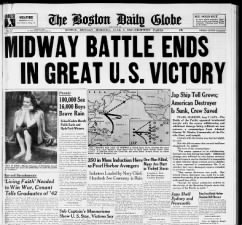 June 8, 1942, newspaper headlines declare "Midway battle ends in great U.S. victory" Mon, Jun 8, 1942 – 1 · The Boston Globe (Boston, Suffolk, Massachusetts, United States of America) · Newspapers.com
June 8, 1942, newspaper headlines declare "Midway battle ends in great U.S. victory" Mon, Jun 8, 1942 – 1 · The Boston Globe (Boston, Suffolk, Massachusetts, United States of America) · Newspapers.com Possible offensive against Japan nears after America’s defeat of Japan during the Battle of Midway Mon, Jun 8, 1942 – 9 · The Oshkosh Northwestern (Oshkosh, Winnebago, Wisconsin, United States of America) · Newspapers.com
Possible offensive against Japan nears after America’s defeat of Japan during the Battle of Midway Mon, Jun 8, 1942 – 9 · The Oshkosh Northwestern (Oshkosh, Winnebago, Wisconsin, United States of America) · Newspapers.com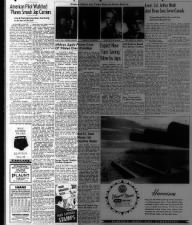 American pilot shares eyewitness firsthand account of Battle of Midway in June 1942 Tue, Jun 9, 1942 – Page 13 · The Ottawa Journal (Ottawa, Ontario, Canada) · Newspapers.com
American pilot shares eyewitness firsthand account of Battle of Midway in June 1942 Tue, Jun 9, 1942 – Page 13 · The Ottawa Journal (Ottawa, Ontario, Canada) · Newspapers.com "Midway Again Proves Case of 'Planes over Warships" 09 Jun 1942, Tue The Ottawa Journal (Ottawa, Ontario, Canada) Newspapers.com
"Midway Again Proves Case of 'Planes over Warships" 09 Jun 1942, Tue The Ottawa Journal (Ottawa, Ontario, Canada) Newspapers.com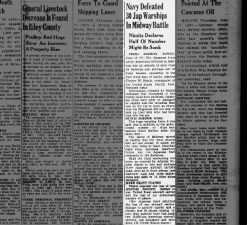 Admiral Chester Nimitz reports US Navy defeated 30 Japanese warships in the Battle of Midway Thu, Jun 11, 1942 – 1 · The Morning Chronicle (Manhattan, Kansas, United States of America) · Newspapers.com
Admiral Chester Nimitz reports US Navy defeated 30 Japanese warships in the Battle of Midway Thu, Jun 11, 1942 – 1 · The Morning Chronicle (Manhattan, Kansas, United States of America) · Newspapers.com "Marines Praised as Real Heroes of Midway Battle," newspaper article says Thu, Jun 11, 1942 – Page 9 · The Minneapolis Star (Minneapolis, Hennepin, Minnesota, United States of America) · Newspapers.com
"Marines Praised as Real Heroes of Midway Battle," newspaper article says Thu, Jun 11, 1942 – Page 9 · The Minneapolis Star (Minneapolis, Hennepin, Minnesota, United States of America) · Newspapers.com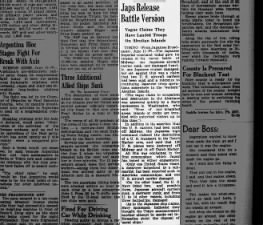 The Japanese imperial command releases its version of the Battle of Midway Thu, Jun 11, 1942 – 1 · The Morning Chronicle (Manhattan, Kansas, United States of America) · Newspapers.com
The Japanese imperial command releases its version of the Battle of Midway Thu, Jun 11, 1942 – 1 · The Morning Chronicle (Manhattan, Kansas, United States of America) · Newspapers.com Picture of "heroes of the battle of Midway island" returning to Oahu field, Hawaii, in June 1942 Thu, Jun 11, 1942 – Page 1 · The Minneapolis Star (Minneapolis, Hennepin, Minnesota, United States of America) · Newspapers.com
Picture of "heroes of the battle of Midway island" returning to Oahu field, Hawaii, in June 1942 Thu, Jun 11, 1942 – Page 1 · The Minneapolis Star (Minneapolis, Hennepin, Minnesota, United States of America) · Newspapers.com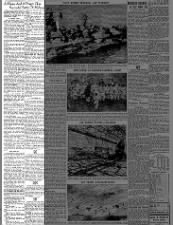 Day-to-day account of the Battle of Midway written by an AP correspondent who witnessed the battle Mon, Jun 22, 1942 – Page 9 · The Daily Telegram (Adrian, Lenawee, Michigan) · Newspapers.com
Day-to-day account of the Battle of Midway written by an AP correspondent who witnessed the battle Mon, Jun 22, 1942 – Page 9 · The Daily Telegram (Adrian, Lenawee, Michigan) · Newspapers.com Photo of the damage inflicted to a Japanese cruiser during the Battle of Midway Mon, Jun 22, 1942 – Page 2 · Pittsburgh Post-Gazette (Pittsburgh, Allegheny, Pennsylvania) · Newspapers.com
Photo of the damage inflicted to a Japanese cruiser during the Battle of Midway Mon, Jun 22, 1942 – Page 2 · Pittsburgh Post-Gazette (Pittsburgh, Allegheny, Pennsylvania) · Newspapers.com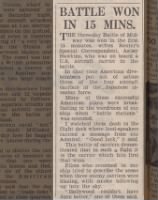 Correspondent says Battle of Midway was "won in the first 15 minutes" 22 Jun 1942, Mon Daily Record (Glasgow, Strathclyde, Scotland) Newspapers.com
Correspondent says Battle of Midway was "won in the first 15 minutes" 22 Jun 1942, Mon Daily Record (Glasgow, Strathclyde, Scotland) Newspapers.com Article reports estimates of Japanese airplane and ship losses during the Battle of Midway Mon, Jun 29, 1942 – Page 1 · The Courier-Journal (Louisville, Jefferson, Kentucky, United States of America) · Newspapers.com
Article reports estimates of Japanese airplane and ship losses during the Battle of Midway Mon, Jun 29, 1942 – Page 1 · The Courier-Journal (Louisville, Jefferson, Kentucky, United States of America) · Newspapers.com Newspaper prints full report provided by the US Navy on the Battle of Midway Wed, Jul 15, 1942 – 10 · The Los Angeles Times (Los Angeles, Los Angeles, California, United States of America) · Newspapers.com
Newspaper prints full report provided by the US Navy on the Battle of Midway Wed, Jul 15, 1942 – 10 · The Los Angeles Times (Los Angeles, Los Angeles, California, United States of America) · Newspapers.com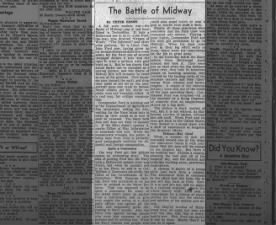 The Battle of Midway is filmed in Technicolor by Hollywood director John Ford Sat, Sep 5, 1942 – 8 · The Morning Post (Camden, New Jersey, United States of America) · Newspapers.com
The Battle of Midway is filmed in Technicolor by Hollywood director John Ford Sat, Sep 5, 1942 – 8 · The Morning Post (Camden, New Jersey, United States of America) · Newspapers.com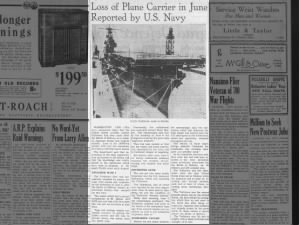 US Navy reports the loss of the aircraft carrier USS Yorktown as a result of the Battle of Midway Wed, Sep 16, 1942 – 2 · Times Colonist (Victoria, British Columbia, Canada) · Newspapers.com
US Navy reports the loss of the aircraft carrier USS Yorktown as a result of the Battle of Midway Wed, Sep 16, 1942 – 2 · Times Colonist (Victoria, British Columbia, Canada) · Newspapers.com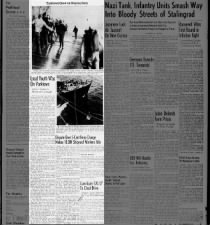 Photos and story of the sinking of the USS Yorktown during the Battle of Midway Sat, Sep 19, 1942 – 1 · The Billings Gazette (Billings, Yellowstone, Montana, United States of America) · Newspapers.com
Photos and story of the sinking of the USS Yorktown during the Battle of Midway Sat, Sep 19, 1942 – 1 · The Billings Gazette (Billings, Yellowstone, Montana, United States of America) · Newspapers.com Clarence W. McClusky's "lightning decision credited with winning Battle of Midway" 19 Mar 1944, Sun St. Louis Post-Dispatch (St. Louis, Missouri) Newspapers.com
Clarence W. McClusky's "lightning decision credited with winning Battle of Midway" 19 Mar 1944, Sun St. Louis Post-Dispatch (St. Louis, Missouri) Newspapers.com List of Japanese and American losses during Battle of Midway 21 Jun 1944, Wed The Tribune (Scranton, Pennsylvania) Newspapers.com
List of Japanese and American losses during Battle of Midway 21 Jun 1944, Wed The Tribune (Scranton, Pennsylvania) Newspapers.com